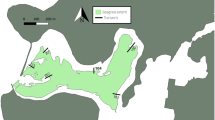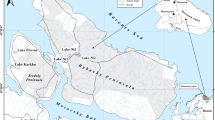Abstract
The objective of this paper is to examine three sediment parameters used in paleolimnological studies, sediment organic, carbonate and biogenic silica (BSi) content, and to quantify the relationship among these parameters and modern environmental conditions for a series of Canadian Arctic lakes. Sediment samples from 63 lakes were analysed for organic, carbonate and BSi content. The environmental and physical parameters of these lakes were recorded. Bedrock composition exerted a very strong influence on sediment organic, BSi and carbonate content, and differences in lake production accounted for much of the remaining variance. The strongest relationships existed among sediment carbonate content, BSi content and water pH. A statistical model developed for predicting water pH provides a new tool for reconstructing past environmental conditions for Arctic aquatic ecosystems. A positive relationship between mean July air temperature and sediment organic and BSi content was detected, but was confounded by effects of bedrock on these parameters. However, the relationship between mean July air temperature and sediment organic and BSi could be even more significant in the context of constant bedrock composition, as is the case in paleolimnological studies.






Similar content being viewed by others
References
Alexander V, Whalen SC, Klingensmith KM (1989) Nitrogen cycling in Arctic lakes and ponds. Hydrobiologia 172:165–172. doi:10.1007/BF00031619
Andresen CS, Björck S, Bennike O, Bond G (2004) Holocene climate changes in southern Greenland: evidence from lake sediments. J Quat Sci 19:783–795. doi:10.1002/jqs.886
Andresen CS, Björck S, Rundgren M, Conley DJ, Jessen C (2006) Rapid Holocene climate changes in the North Atlantic: evidence from lake sediments from the Faroe Islands. Boreas 35:23–34. doi:10.1080/03009480500359228
Atkinson D, Gajewski K (2002) High-resolution estimation of summer surface air temperature in the Canadian Arctic Archipelago. J Clim 15:3601–3614. doi:10.1175/1520-0442(2002)015<3601:HREOSS>2.0.CO;2
Axford Y, Geirsdóttir Á, Miller GH, Langdon PG (2009) Climate of the Little Ice Age and the past 2000 years in northeast Iceland inferred from chironomids and other lake sediment proxies. J Paleolimnol. doi:10.1007/s10933-008-9251-1
Barker P, Fontes J-C, Gasse F, Druart J-C (1994) Experimental dissolution of diatom silica in concentrated salt solutions and implications for paleoenvironmental reconstructions. Limnol Oceanogr 39:99–110
Birks HJB, Birks HH (1980) Quaternary palaeoecology. Edward Arnold, London
Bouchard G, Gajewski K, Hamilton PB (2004) Freshwater diatom biogeography in the Canadian Arctic Archipelago. J Biogeogr 31:1955–1973. doi:10.1111/j.1365-2699.2004.01143.x
Brodersen KP, Quinlan R (2006) Midges as palaeoindicators of lake productivity, eutrophication and hypolimnetic oxygen. Quat Sci Rev 25:1995–2012. doi:10.1016/j.quascirev.2005.03.020
Bunbury J, Gajewski K (2008) Does a one-point sample adequately characterize the lake environment for paleoenvironmental calibration studies? J Paleolimnol 39:511–531. doi:10.1007/s10933-007-9127-9
Chipman ML, Clarke GH, Clegg BF, Gregory-Eaves I, Hu FS (2009) A 2000-year record of climatic change at Ongoke Lake, southwest Alaska. J Paleolimnol. doi:10.1007/s10933-008-9257-8
Colman SM, Peck JA, Karabanov EB, Carter SJ, Bradbury JP, King JW, Williams DF (1995) Continental climate response to orbital forcing from biogenic silica records in Lake Baikal. Nature 378:769–771. doi:10.1038/378769a0
Conley DJ (1988) Biogenic silica as an estimate of siliceous microfossil abundance in Great Lakes sediments. Biogeochemistry 6:161–179. doi:10.1007/BF02182994
Conley DJ (1998) An interlaboratory comparison for the measurement of biogenic silica in sediments. Mar Chem 63:39–48. doi:10.1016/S0304-4203(98)00049-8
Conley DJ, Schelske CL (2001) Biogenic silica. In: Smol JP, Birks HJB, Last WM (eds) Tracking environmental change using lake sediments. Volume 3: terrestrial, algal and siliceous indicators. Kluwer, Dordrecht, pp 281–310
Dean WE (1974) Determination of carbonate and organic matter in calcareous sediments and sedimentary rocks by loss on ignition: comparison with other methods. J Sediment Petrol 44:242–248
Dean WE (1999) The carbon cycle and biogeochemical dynamics in lake sediments. J Paleolimnol 21:375–393. doi:10.1023/A:1008066118210
DeMaster DJ (1981) The supply and accumulation of silica in the marine environment. Geochim Cosmochim Acta 45:1715–1732. doi:10.1016/0016-7037(81)90006-5
Environment Canada (1994) Manual of analytical methods. Major ions and nutrients, vol 1 and trace metals, vol 2. National Laboratory for Environmental Testing. Canadian Centre for Inland Waters, Burlington
Eppley RW, Harrison WG, Chisolm SW, Stuart E (1977) Particulate organic matter in surface waters off California, and its relation to photosynthesis. J Mar Res 35:671–696
Finkelstein SA, Gajewski K (2007) Responses of Fragilarioid-dominated diatom assemblages in a small Arctic lake to Holocene climatic changes, Russell Island, Nunavut, Canada. J Paleolimnol 40:1079–1095
Flower RJ (1993) Diatom preservation: experiments and observations on dissolution and breakage in modern and fossil material. Hydrobiologia 269/270:473–484. doi:10.1007/BF00028045
Fortin M-C, Gajewski (accepted) Holocene climate change and its effect on lake ecosystem production on Northern Victoria Island, Canadian Arctic. J Paleolimnol
Gajewski K, Bouchard G, Wilson S, Kurek J, Cwynar L (2005) Distribution of Chironomidae (Insecta: Diptera) head capsules in recent sediments of Canadian Arctic lakes. Hydrobiologia 549:131–143. doi:10.1007/s10750-005-5444-z
Garneau M, Alt BT (2000) Environmental response to climate change in the Canadian High Arctic. Geological Survey of Canada, Bulletin 529. Natural Resources Canada, Ottawa
Geirsdòttir Á, Miller GH, Thordarson T, Ólafsdòttir K (2009) A 2000-year record of climate variations reconstructed from Haukadalsvatn, West Iceland. J Paleolimnol. doi:10.1007/s10933-008-9253-z
Håkanson L, Jansson J (1983) Principles of lake sedimentology. Springer, Berlin
Hamilton PB, Gajewski K, Atkinson DE, Lean DRS (2001) Physical and chemical limnology of 204 lakes from the Canadian Arctic Archipelago. Hydrobiologia 457:133–148. doi:10.1023/A:1012275316543
Heiri O, Lotter AF, Lemcke G (2001) Loss on ignition as a method for estimating organic and carbonate content in sediments: reproducibility and comparability of results. J Paleolimnol 25:101–110. doi:10.1023/A:1008119611481
Hobbie J (1984) Polar Limnology. In: Taub F (ed) Lake and reservoirs. Elsevier, Amsterdam, pp 63–105
Hu FS, Kaufman D, Yoneji S, Nelson D, Shemesh A, Huang Y, Tian J, Bond G, Clegg B, Brown T (2003) Cycling variation and solar forcing of Holocene climate in the Alaskan subarctic. Science 301:1890–1893. doi:10.1126/science.1088568
Hurd DC (1983) Physical and chemical properties of siliceous skeletons. In: Aston SR (ed) Silicon geochemistry and biogeochemistry. Academic Press, New York, pp 187–242
Kalff J (1971) Nutrient limiting factors in an Arctic tundra pond. Ecology 52:655–659. doi:10.2307/1934154
Kalff J (2001) Limnology. Prentice Hall, New Jersey
Kaplan MR, Wolfe AP, Miller GH (2002) Holocene environmental variability in Southern Greenland inferred from lake sediments. Quat Res 58:149–159. doi:10.1006/qres.2002.2352
Kaufman DS (2009) An overview of late Holocene climate and environmental change inferred from Arctic lake sediment. J Paleolimnol. doi:10.1007/s10933-008-9259-6
Levesque AJ, Mayle FE, Walker IR, Cwynar LC (1993) A previously unrecognized late-glacial cold event in eastern North America. Nature 361:623–626
Lim DSS, Douglas MSV, Smol JP, Lean DRS (2001) Physical and chemical limnological characteristics of 38 lakes and ponds on Bathurst Island, Nunavut, Canadian High Arctic. Int Rev Hydrobiol 86:1–22. doi:10.1002/1522-2632(200101)86:1<1::AID-IROH1>3.0.CO;2-E
MacDonald GM, Porinchu DF, Rolland N, Kremenetsky K, Kaufman DS (2009) Paleolimnological evidence of the response of the central Canadian treeline zone to radiative forcing and hemispheric patterns of temperature change over the past 2000 years. J Paleolimnol. doi:10.1007/s10933-008-9250-2
McKay NP, Kaufman DS (2009) Holocene climate and glacier variability at Hallet and Greyling Lakes, Chugach Mountains, south-central Alaska. J Paleolimnol. doi:10.1007/s10933-008-9260-0
McKay NP, Kaufman DS, Michelutti N (2008) Biogenic silica concentration as a high-resolution, quantitative temperature proxy at Hallet Lake, south-central Alaska. Geophys Res Lett 35:L05709. doi:10.1029/2007GL032876
Michelutti N, Douglas MSV, Lean DRS, Smol JP (2002a) Physical and chemical limnology of 34 ultra-oligotrophic lakes and ponds near Wynniatt Bay, Victoria Island, Arctic Canada. Hydrobiologia 484:1–13. doi:10.1023/A:1021201704844
Michelutti N, Douglas MSV, Muir DCG, Wang X, Smol JP (2002b) Limnological characteristics of 38 lakes and ponds on Axel Heiberg Island, High Arctic Canada. Int Rev Hydrobiol 87:385–399. doi:10.1002/1522-2632(200207)87:4<385::AID-IROH385>3.0.CO;2-3
Michelutti N, Douglas MSV, Wolfe AP, Smol JP (2006) Heightened sensitivity of a poorly buffered high Arctic lake to Late-Holocene climatic change. Quat Res 65:421–430. doi:10.1016/j.yqres.2006.02.001
Okulitch AV (1991) Geology of the Canadian Arctic Archipelago, Northwest Territories and North Greenland. Geological map of Canada. Geological Survey of Canada, Map1715A
Parsons TR, Maita Y, Lalli CM (1984) A manual of chemical and biological methods for seawater analysis. Pergamon, Oxford
Peros MC, Gajewski K (2009) Pollen-based reconstructions of late Holocene climate from the central and western Canadian Arctic. J Paleolimnol. doi:10.1007/s10933-008-9256-9
Porinchu DF, MacDonald GM, Rolland N (2009) A 2000-year midge-based paleotemperature reconstruction from the Canadian Arctic Archipelago. J Paleolimnol. doi:10.1007/s10933-008-9263-x
Prentki RT, Miller MC, Barsdate RJ, Alexander V, Kelley J, Coyne P (1980) Chemistry. In: Hobbie JE (ed) Limnology of tundra ponds. Dowden, Hutchinson and Ross, Stroudsburg
Psenner R, Schmidt R (1992) Climate-driven pH control of remote alpine lakes and effects of acid decomposition. Nature 356:781–783. doi:10.1038/356781a0
Rowan DJ, Kalff J, Rasumssen JB (1992) Profundal sediment organic content and physical character do not reflect lake trophic status, but rather reflect inorganic sedimentation and exposure. Can J Fish Aquat Sci 49:1431–1438. doi:10.1139/f92-158
Ryves DB, Battarbee RW, Juggins S, Fritz SC, Anderson NJ (2006) Physical and chemical predictors of diatom dissolution in freshwater and saline lake sediments in North America and West Greenland. Limnol Oceanogr 51:1355–1368
Ryves DB, Battarbee RW, Fritz SC (2008) The dilemma of disappearing diatoms: incorporating diatom dissolution data into palaeoenvironmental modelling and reconstruction. Quat Sci Rev 28:120–136. doi:10.1016/j.quascirev.2008.08.021
Smol JP (1983) Paleophycology of a high Arctic lake near Cape Herschel, Ellesmere Island. Can J Bot 61:2195–2204
Sokal RR, Rohlf FJ (1981) Biometry, 2nd edn. WH Freeman and company, New York
Team CAVM (2003) Circumpolar Arctic vegetation map. Scale 1:7, 500, 000. Conservation of Arctic flora and fauna (CAFF) map no.1. US Fish and Wildlife Service, Anchorage
Thomas EK, Briner JP (2009) Climate of the past millennium inferred from varved proglacial lake sediments on northeast Baffin Island, Arctic Canada. J Paleolimnol. doi:10.1007/s10933-008-9258-7
Wetzel RG (2001) Limnology: lake and river ecosystems, 3rd edn. Academic, San Diego
Wheeler JO, Hoffman PF, Card KD, Davidson A, Sanford BV, Okulitch AV, Roest WR (comp.) (1997) Geological map of Canada, MapD1860A. Geological Survey of Canada
Willemse NW, Törnqvist TE (1999) Holocene century-scale temperature variability from West Greenland lake records. Geology 27:580–584. doi:10.1130/0091-7613(1999)027<0580:HCSTVF>2.3.CO;2
Wolfe A (2002) Climate modulates the acidity of Arctic lakes on millennial time scales. Geology 30:215–218. doi:10.1130/0091-7613(2002)030<0215:CMTAOA>2.0.CO;2
Acknowledgments
Funding for this study was provided by a grant from the Canada Foundation for Climate and Atmospheric Sciences (CFCAS), Discovery Grants from the Natural Sciences and Engineering Research Council of Canada (NSERC) and an Ontario Graduate Scholarship (OGS). Logistic support was provided by the Polar Continental Shelf Project (PCSP/EPCP); this paper is PCSP contribution 02208. We thank P. Hamilton for help with the field work and T. Paull for help in producing the figures. We would also like to thank the two reviewers for their comments and their help in the final stages of this study.
Author information
Authors and Affiliations
Corresponding author
Rights and permissions
About this article
Cite this article
Fortin, MC., Gajewski, K. Assessing the use of sediment organic, carbonate and biogenic silica content as indicators of environmental conditions in Arctic lakes. Polar Biol 32, 985–998 (2009). https://doi.org/10.1007/s00300-009-0598-1
Received:
Revised:
Accepted:
Published:
Issue Date:
DOI: https://doi.org/10.1007/s00300-009-0598-1




